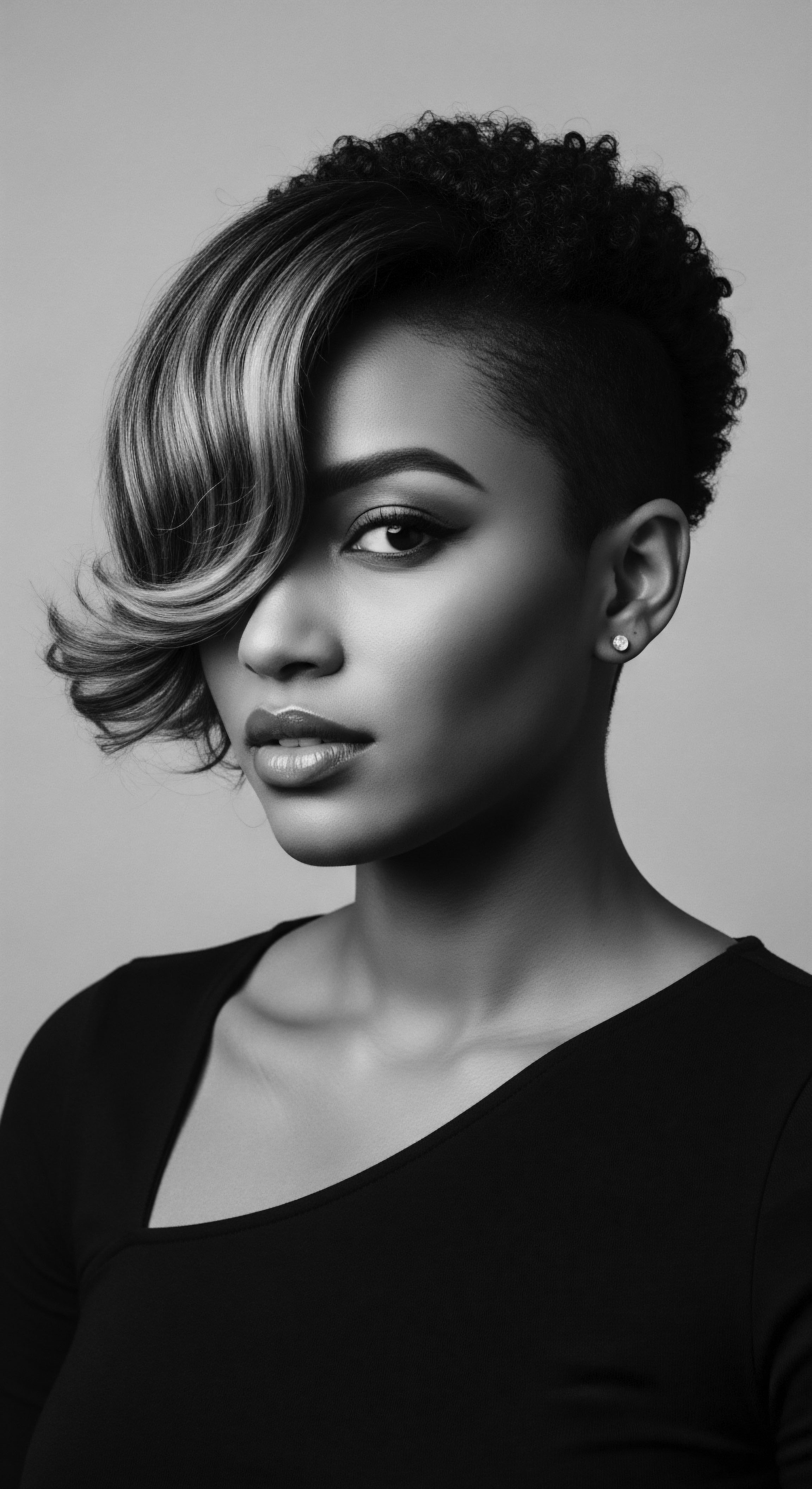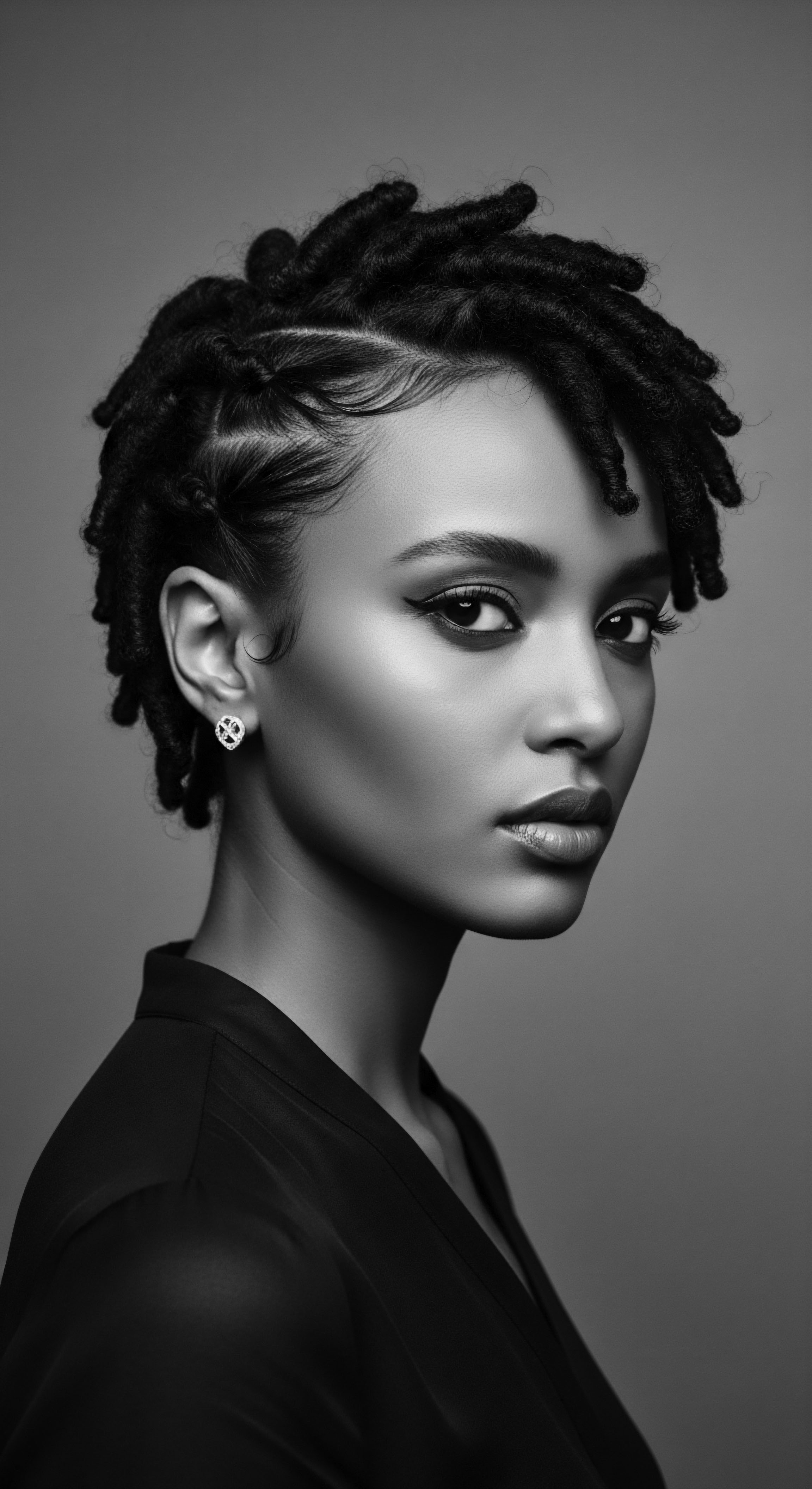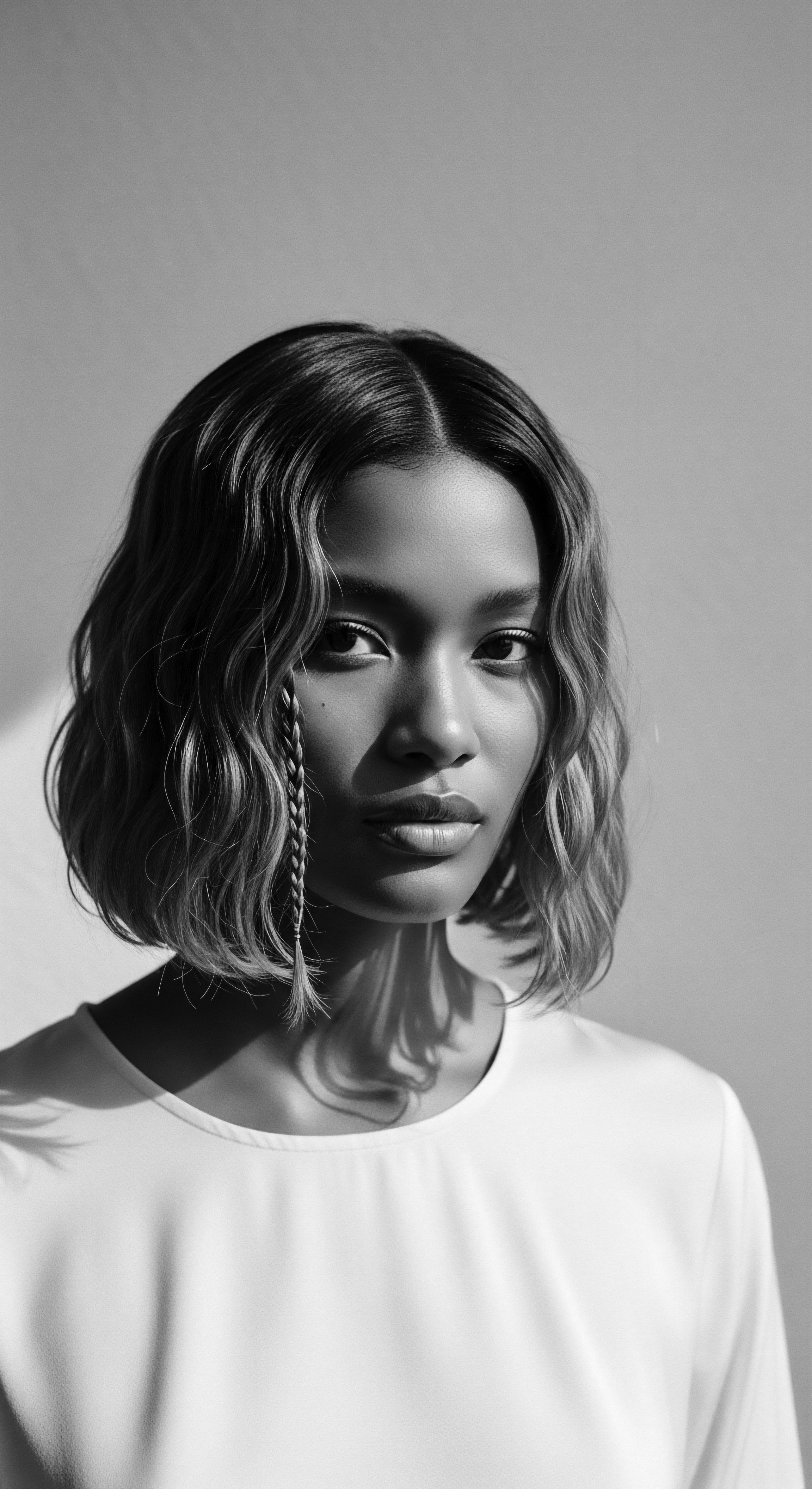
Fundamentals
The Shea Tree, known botanically as Vitellaria paradoxa, stands as a venerable sentinel across the West African savanna, its presence a profound gift to communities and a cornerstone of textured hair heritage. Its designation, often spoken with reverence in various indigenous tongues, points to its life-sustaining properties. This remarkable botanical entity, often reaching heights that command the horizon, yields a fruit housing a nut from which a rich, creamy butter is extracted. This butter, Shea butter, represents a foundational element in traditional wellness and beauty practices, particularly for the intricate needs of hair with natural coils and curls.
The simple explanation of the Shea Tree’s purpose, especially for those new to its story, centers on its unparalleled ability to provide deep, abiding moisture and protection. For generations, this golden balm has been the first line of defense against the sun’s persistent warmth and the arid winds, shielding hair strands from environmental challenges. It acts as a natural sealant, helping to retain the precious hydration within the hair’s very structure, a crucial function for hair types prone to dryness. Its very being speaks to a natural solution, patiently offered by the earth, for maintaining hair’s resilience and vitality.
The Shea Tree offers a timeless balm, a natural wellspring of moisture and protection, foundational to the health and vitality of textured hair.
The tree itself, often called the “Tree of Life” in certain regions, signifies far more than a mere plant. It embodies a living legacy, a silent witness to countless generations who have relied upon its generosity. The process of transforming the shea nut into butter is itself a ritual, often performed by women, connecting them to their ancestors through shared labor and song.
This connection to the source, to the very earth from which it springs, imbues the butter with a particular power, recognized not just for its physical benefits but for its spiritual and communal significance. It is a symbol of sustenance, both tangible and intangible, for the communities that depend upon it.
- Traditional Nourishment ❉ Shea butter was historically used to condition hair, imparting a soft, pliable quality to curls and coils.
- Scalp Health ❉ Applied to the scalp, it addressed dryness and flaking, promoting an environment conducive to healthy hair growth.
- Protective Barrier ❉ It served as a shield against harsh climatic conditions, preventing breakage and environmental damage to delicate strands.
- Styling Aid ❉ The butter’s pliable texture made it an ideal agent for shaping and maintaining traditional hairstyles, from intricate braids to elaborate twists.

Intermediate
Moving beyond its fundamental utility, the Shea Tree’s significance deepens as we consider its role as a living archive of cultural practice and communal strength. Its meaning extends into the very fabric of West African societies, where the collection, processing, and application of Shea butter represent not merely economic activities but deeply ingrained social and cultural rituals. The Shea Belt, stretching across the continent, marks a region where the tree is inextricably linked to the identity and prosperity of countless communities, particularly the women who are its primary cultivators and processors.
The historical dimension of Shea butter’s application in hair care reveals a sophisticated understanding of natural ingredients long before modern scientific inquiry. Ancestral practices, honed over centuries, recognized the unique lipid profile of Shea butter—its balance of saturated and unsaturated fatty acids, alongside unsaponifiable matter rich in vitamins and triterpenes—as ideal for the specific needs of textured hair. This deep understanding, often transmitted orally and through hands-on teaching from elder to younger, formed a knowledge system that sustained healthy hair within communities, adapting to various environmental and social conditions. The butter’s particular constitution provided a unique barrier, protecting the intricate structure of coiled hair from desiccation and mechanical stress.
The Shea Tree’s meaning transcends simple utility, embodying a rich heritage of communal knowledge, economic empowerment, and sophisticated traditional hair care practices.
Consider the daily rhythm of life in a village where Shea trees abound. The morning might begin with women gathering the fallen nuts, their hands working in concert, their voices sharing stories and songs. This collective effort, from cracking the nuts to roasting, grinding, and then meticulously kneading the paste until the butter separates, is a testament to shared purpose.
The resulting Shea butter, often a family’s most valued possession, was then carefully apportioned for cooking, medicinal applications, and, of course, the ritualistic care of hair. This was not a commodity purchased; it was a resource harvested, transformed, and shared, binding families and communities together.
The application of Shea butter to hair was often a moment of familial connection, a tender exchange between mother and child, sister and sister. It was a time for storytelling, for imparting wisdom, for reinforcing bonds. The gentle massage of Shea butter into the scalp, the careful distribution along the hair strands, was a physical manifestation of care and belonging.
This was the foundation of hair wellness, rooted in ancestral wisdom and reinforced by community. The Shea Tree, in this context, stands as a symbol of self-sufficiency, of wisdom passed down through generations, and of a profound connection to the land that provides.
| Aspect Primary Purpose |
| Traditional Community Use Holistic hair and scalp nourishment, ritualistic care, familial bonding. |
| Early Commercial/Trade Use Bulk commodity for external markets, often as raw material for soap or early cosmetics. |
| Aspect Processing Method |
| Traditional Community Use Labor-intensive, artisanal, often collective, preserving specific cultural techniques. |
| Early Commercial/Trade Use Initial focus on quantity over artisanal quality; rudimentary extraction for transport. |
| Aspect Application |
| Traditional Community Use Direct, unrefined application to hair and skin, often as part of daily regimen. |
| Early Commercial/Trade Use Incorporation into manufactured products, sometimes blended with other ingredients. |
| Aspect Cultural Value |
| Traditional Community Use Deeply ingrained in social fabric, identity, and intergenerational knowledge transfer. |
| Early Commercial/Trade Use Economic value as a trade good, contributing to local economies. |
| Aspect The evolution of Shea butter's role from a sacred, community-bound resource to a global commodity highlights the enduring adaptability and economic significance of this ancestral gift. |

Academic
The Shea Tree, Vitellaria paradoxa, holds an exceptionally rich and multifaceted academic definition, particularly when examined through the lens of ethnobotany, economic anthropology, and the specialized biochemistry of its fruit’s lipid content, all converging on its irreplaceable role in textured hair heritage. Its designation as a critical resource stems from its unique oleaginous yield—Shea butter—a complex triglyceride composed predominantly of oleic and stearic acids, alongside a remarkable unsaponifiable fraction (typically 5-17%), which differentiates it markedly from other vegetable fats. This unsaponifiable matter, rich in triterpene alcohols (like alpha-amyrin and lupeol), phytosterols, and tocopherols, confers its distinctive emollient, anti-inflammatory, and antioxidant properties, rendering it singularly effective for the particular physiological requirements of hair with natural coils, kinks, and curls.
The academic understanding of Shea butter’s interaction with textured hair extends beyond simple moisturization. The unique helical structure of coily and kinky hair strands, characterized by multiple twists and turns along their length, creates natural points of vulnerability where the cuticle layers can lift, leading to increased porosity and susceptibility to moisture loss and mechanical damage. The substantive lipid profile of Shea butter, particularly its melting point approximating body temperature, allows it to form a semi-occlusive layer on the hair shaft.
This layer not only reduces transepidermal water loss from the scalp and minimizes moisture evaporation from the hair strand but also provides a lubricating effect, thereby reducing friction between individual hair fibers and external surfaces. This physical protection is paramount for minimizing breakage in hair types that are inherently more fragile due to their structural morphology.
Academic inquiry into the Shea Tree unveils a profound synergy between its unique biochemical composition and the inherent structural needs of textured hair, affirming centuries of ancestral wisdom.
A rigorous examination of its historical and cultural trajectory reveals how Shea butter’s economic value has been inextricably linked to the sustenance of traditional hair care practices across the “Shea Belt” of West Africa. For centuries, the economic activity surrounding Shea butter production has been almost exclusively the domain of women, fostering a robust, intergenerational knowledge transfer system. This system is not merely about technique but also about the deep cultural meaning embedded in hair care rituals.
Consider, for instance, the socio-economic and cultural landscape of Burkina Faso, a nation deeply rooted in Shea production. A study by Lovett and Attah (2018) highlighted the significant contribution of women’s Shea cooperatives to household incomes, which, in turn, directly supported the continuation of traditional practices, including hair care. These cooperatives, some with histories spanning decades, represent a formalized continuation of ancestral knowledge systems. The revenue generated from Shea butter sales allowed families to purchase essential goods, ensuring stability that permitted the allocation of time and resources to labor-intensive, yet culturally vital, hair maintenance routines.
Without the economic foundation provided by Shea, the intricate, time-honored methods of hair cleansing, conditioning, and styling—which often required hours of communal effort—might have eroded under modern pressures. The economic viability of Shea butter production, therefore, acts as a protective mechanism for the preservation of ancestral hair care traditions, ensuring that the knowledge of its optimal application for textured hair continues to be passed down through generations, rather than becoming a forgotten relic. This particular dynamic underscores how economic agency, rooted in indigenous resources, directly safeguards cultural heritage.
The sophisticated understanding of Shea butter’s meaning within traditional contexts often predated modern scientific validation. Ethnobotanical accounts from various West African groups, such as the Dagomba people of Ghana, delineate specific uses for Shea butter that align remarkably with contemporary dermatological and trichological insights. For instance, its application to the scalp was not merely for comfort but to address specific conditions—from dry, flaky scalp to minor abrasions—a testament to its recognized anti-inflammatory and wound-healing properties attributed to its triterpene content.
Furthermore, its efficacy in preparing hair for protective styles, such as intricate braiding patterns, by enhancing pliability and reducing friction, reflects an intuitive grasp of hair mechanics. The ancestral knowledge, therefore, represents a form of empirical science, developed over millennia through observation and refinement.
The impact of the Shea Tree’s continued use extends to the psychological and social well-being of individuals within Black and mixed-race communities globally. For many, the choice to use Shea butter in their hair care regimen is an active affirmation of identity, a reclamation of ancestral practices in a world that has often marginalized textured hair. This connection to a natural, indigenous ingredient, steeped in the heritage of one’s forebears, fosters a sense of pride and self-acceptance. The long-term consequences of this embrace include a shift away from chemically harsh treatments towards more gentle, nourishing approaches, contributing to healthier hair and scalp environments.
Moreover, the global demand for ethically sourced Shea butter has begun to empower the very women and communities who have historically stewarded this resource, creating a virtuous cycle where economic development supports cultural preservation. The Shea Tree, in this academic interpretation, is not just a botanical specimen but a living bridge between ancestral wisdom, contemporary science, and future pathways for cultural affirmation and sustainable development.
- Lipid Profile ❉ The unique ratio of stearic and oleic acids in Shea butter provides a balanced emollient effect, crucial for maintaining moisture in porous textured hair.
- Unsaponifiable Matter ❉ This distinct fraction, rich in triterpenes and phytosterols, accounts for the butter’s therapeutic qualities, including anti-inflammatory and antioxidant benefits for the scalp.
- Cuticular Protection ❉ Shea butter’s film-forming capabilities reduce cuticle lift and minimize friction, directly addressing the structural vulnerabilities of coily and kinky hair.
- Melting Point ❉ Its low melting point, close to body temperature, allows for optimal spreadability and absorption into the hair shaft, enhancing its conditioning properties.
The delineation of Shea butter’s precise chemical meaning and its physiological interactions with hair provides a robust framework for understanding its efficacy. It clarifies why this ancestral ingredient remains unparalleled for textured hair care. This scientific substantiation does not diminish the spiritual or cultural essence of the Shea Tree but rather provides a deeper, empirical appreciation for the wisdom of those who first recognized its potent properties. It serves as a compelling instance where traditional ecological knowledge finds resonance and validation within the paradigms of modern scientific inquiry.

Reflection on the Heritage of Shea Tree
The enduring presence of the Shea Tree in our collective consciousness, particularly within the realm of textured hair, is a profound testament to ancestral ingenuity and persistent cultural memory. Its story is not merely one of botanical utility but a vibrant, breathing narrative of resilience, identity, and profound connection to the earth. The Shea Tree, through its precious butter, has long served as a quiet, yet powerful, anchor for Black and mixed-race hair experiences, providing a tangible link to practices honed across generations and continents. It whispers tales of grandmothers’ hands, of communal gatherings under the African sun, and of the sacred act of nurturing one’s own crown.
As we gaze upon the future of textured hair care, the Shea Tree stands as a timeless beacon, reminding us that the deepest wisdom often resides in the oldest ways. It encourages us to look inward, to our own ancestral roots, for the answers to contemporary challenges. The ‘Soul of a Strand’ ethos finds its living embodiment in this remarkable tree, urging us to recognize that true beauty and wellness stem from a harmonious relationship with our heritage, our bodies, and the natural world. The journey of Shea from ancient savannas to modern hair rituals underscores a continuous, unbroken lineage of care, a legacy that continues to shape and inform our understanding of what it means to truly honor textured hair.

References
- Lovett, A. A. & Attah, K. (2018). The Political Economy of Shea Butter in Ghana ❉ A Case Study of Women’s Livelihoods. African Economic History.
- Maranz, S. (2009). Shea Butter ❉ A Global Resource. CRC Press.
- Boutin, B. (1999). The Shea Tree ❉ A Multipurpose Species in the West African Sahel. FAO.
- Kapseu, C. & Tchiegang, C. (2009). The Shea Butter Processing Industry in Africa. Academic Press.
- Akinwunmi, O. (2015). The Economic History of West Africa ❉ A Reinterpretation. James Currey.
- Robbins, C. R. (2012). Chemical and Physical Behavior of Human Hair. Springer.
- Mboumba, S. & Ndong, J. (2018). Traditional Uses of Plants in African Hair Care. Journal of Ethnopharmacology.
